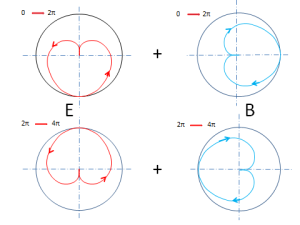The Dutch Paradigm postulates that only two types of entities are released at the Big Bang: the photon and the neutrino. All other fundamental particles are either these two particles but at different levels of frequency, or they are part of the construct of the electron.
The neutrino is the second type of particle. It exhibits similar electromagnetic properties as the photon, along with an additional rotation of these properties.
The comparison with the present state of knowledge of the neutrino is:
Wikipedia:
A neutrino is an electrically neutral, weakly interacting elementary subatomic particle with half-integer spin. The neutrino (meaning “small neutral one” in Italian) is denoted by the Greek letter ν (nu). All evidence suggests that neutrinos have mass but the upper bounds established for their mass are tiny even by the standards of subatomic particles.
Neutrinos do not carry electric charge, which means that they are not affected by the electromagnetic forces that act on charged particles such as electrons and protons. Neutrinos are affected only by the weak sub-atomic force, of much shorter range than electromagnetism, and gravity, which is relatively weak on the subatomic scale. Therefore a typical neutrino passes through normal matter unimpeded.
Neutrinos are created as a result of certain types of radioactive decay, or nuclear reactions such as those that take place in the Sun, in nuclear reactors, or when cosmic rays hit atoms. There are three types, or “flavours“, of neutrinos: electron neutrinos, muon neutrinos and tau neutrinos. Each type is associated with an antiparticle, called an “antineutrino”, which also has neutral electric charge and half-integer spin. Whether or not the neutrino and its corresponding antineutrino are identical particles has not yet been resolved, even though the antineutrino has an opposite chirality to the neutrino.
Most neutrinos passing through the Earth emanate from the Sun. About 65 billion (6.5×1010) solar neutrinos per second pass through every square centimetre perpendicular to the direction of the Sun in the region of the Earth.
The neutrino was postulated first by Wolfgang Pauli in 1930 to explain how beta decay could conserve energy, momentum, and angular momentum (spin). This was relevant for the beta decay of a naked neutron into a proton, electron and an anti-neutrino.
The manifestations of neutrinos must interfere with other particles in order to be observed. According to The Dutch Paradigm, these interferences occur with either another neutrino or a photon. However, these interference capabilities have not been replicated under laboratory conditions, so this claim has not yet been experimentally validated.
The scientific claims for the physical properties of a neutrino are as indicated in bold characters:
1. Neutrinos are created by radioactive decay, nuclear reactors or when cosmic rays hit atoms
Neutrinos are only emitted at the very start of the universe, alike the photons. Through interference with their electromagnetic manifestations, these neutrinos have become part of constructs. If a construct decays or fuse, neutrinos are released. These are the muon neutrinos and tau neutrinos, with modified electromagnetic properties. These modifications reflect the interference history
2. A neutrino has ½ spin and therefore is a fermion
The convention to classify a neutrino is by identification of ½ spin.
3. A neutrino has a very small mass manifestation
Due to a potential breach of the speed of light of the rotating electromagnetic manifestations, there is a modification in these manifestations. That induces a transfer of energy into mass manifestation.
There is a separate chapter that provides an explanation of this phenomenon.
4. A neutrino has a small magnetic momentum
The small magnetic momentum is measured and in line with the expectations as in The Dutch Paradigm. It is the consequence of preference in chirality.
5. A neutrino has a speed slightly lower than the speed of light
A neutrino has a tiny mass. Consequently, the assumption is that a naked neutrino cannot propagate at the speed of light.
6. A neutrino can have left or right spin
This aligns with the Dutch Paradigm.
7. Neutrinos show variance in the mass
That variance is discussed under 1. The properties of the electromagnetic manifestations of the neutrino reflect the interference history of the neutrino entity. Measuring the properties of the neutrino under lab conditions is difficult due to the lack of observable interference of neutrinos with other particles and constructs.
Following The Dutch Paradigm, that is a misconception. The ½ spin behavior of Fermions is neutrino ½ spin behavior. Therefore, interference of a neutrino and a photon is assumed to be possible, as will be explained further on with forming the construct electron.
The numerical values of the physical properties of a neutrino are approximations but are useable for making order-of-magnitude calculations. These calculations are in a separate section.
At first glance, there are no significant discrepancies in our knowledge and measurements of neutrinos compared to the model described in The Dutch Paradigm.
Neutrinos exhibit a unique behavior that is not fully understood by science. When passing through magnetic fields, neutrinos demonstrate oscillation in spin direction. This phenomenon is explained as a logical consequence of also the particle/wave duality of neutrinos.

